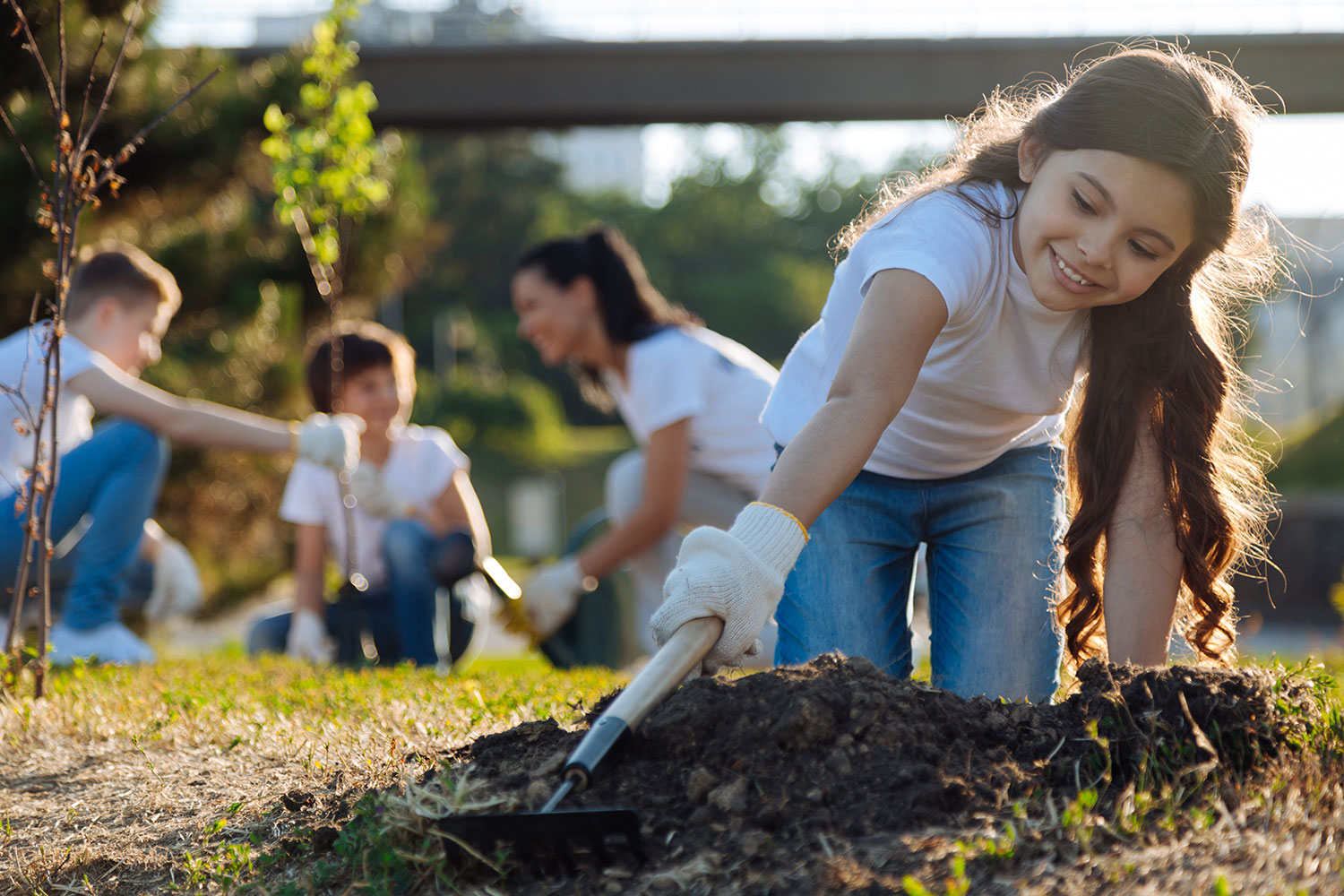When Kids Volunteer: Liability Basics
If kids are among your clients or constituents, then getting them involved is a natural. But you’ll want to be sure you’ve got basic protections in place first.

When kids volunteer, be sure you know how to protect them and your nonprofit.
Whether kids sell cookies or help clean up a park, they are welcome volunteers. Just be sure you know the basics of how to protect them and your organization when it comes to liabilities (at the end of this article is a link to a sample waiver):
As a kid, I sorted food donations for Lithuanian refugees because my mother was a leader in the Seattle Lithuanian Community. I sold Camp Fire Girls’ mints because, well, I had to. I interned at the Seattle Aquarium where I wore a badge that said, “Ask me! I know everything!” And I interned at Children’s Hospital because I hoped it would make my college applications look better.
But somewhere along the way, something must have clicked, because by the time I finished law school, I asked my corporate law firm employer, “Could you wait six months while I intern at Amnesty International?” And a few years later when I quit corporate law, the first thing I did was a volunteer internship at Northwest Immigrant Rights Project.
If my experience is a guide, a childhood experience as a volunteer can lead to a lifelong commitment to giving back. And if kids are among your clients or constituents, then getting them involved is a natural. But you’ll want to be sure you’ve got basic protections in place (I guess I haven’t completely shed my lawyer hat!).
Liability basics for children volunteers
Here are the first things to think about:
Screening process
If you don’t already have a screening process in place for adults who will be working directly with children, or will be driving them around, now’s the time to start one.
Accident-prevention procedures
If the kids will be doing anything remotely risky, then you’ll want to give explicit accident-prevention strategies in your trainings and written materials, and be ready to enforce compliance. For example, if long-sleeved shirts are advisable when the kids are working with animals, then you’ll have to not only give advance notice of this, but turn kids away who are improperly dressed, or at least have a spare sweatshirt on hand for them to borrow.
Liability insurance
Make sure your liability insurance covers the activities planned within your volunteer program. Review your policy and talk to your insurance provider.
Parental consent
When children younger than 18 are involved, you’ll also need to get written parental consent. Your permission form will document not only the parent’s permission for the child to partake in your activity, but should also contain a promise that the parent will not sue your organization in the event that the child is injured as a result of the carelessness of your volunteers or participants. Note that the effectiveness of parental waivers is a fraught topic in the law; when challenged, some waivers do not hold up—their effectiveness depends on the law in your state and the way the waiver was written.
Attached to this article is a sample parental waiver; click here to download it for free. It’s impossible to create a sample waiver that does the trick for all states for every type of activity. But this form can give you and your attorney something to start with… and I do suggest you hire a competent lawyer for advice and drafting help.
Scaring parents?
You’ll see that the sample waiver lays out a whole host of possible risks, from broken bones to death. Will you be scaring parents by doing the same within your form? Don’t worry: Most parents would rather know what’s possible than be surprised later, and will understand that this type of language is legally required. In fact, the more specific a waiver is regarding the actual risks that the child, student, or other volunteer will be exposed to, the more likely a court is to uphold its validity.
So why have kids as volunteers?
There are important roles for kids to play as volunteers, whether to help on their own projects (like raising money for their soccer team) or to help others. And such activities are good for kids, too. If you have adult volunteers with children, think of activities they can do with their children — maybe passing out water bottles at a walk-a-thon, or staffing a table at a street fair.
Margo, a parent, told me of her daughter’s sales of Girl Scout cookies and items for school fundraisers: “In addition to learning how to make change and use basic math, one of the most important things she learned was how to take ‘No’ for an answer.” And another life lesson I learned from my own childhood volunteer work: Rich people don’t necessarily buy more mints.
See also:
- Criminal Records Checks for Prospective Staff and Volunteers
- A Board Member’s Guide to Nonprofit Insurance
- All-Volunteer Organization Resources
- Fundraising Confessions of a Former Camp Fire Girl
You might also like:
- As Nonprofits Face the DEI Wars, Can a “Prohuman” Approach Help?
- Five Internal Controls for the Very Small Nonprofit
- A Practical Guide to Getting and Keeping Nonprofit Volunteers
- Treasurers of All-Volunteer Organizations: Eight Key Responsibilities
- Drive Your Nonprofit’s Mission by Investing in Your People
You made it to the end! Please share this article!
Let’s help other nonprofit leaders succeed! Consider sharing this article with your friends and colleagues via email or social media.
About the Author
Ilona Bray, J.D. is the author of The Volunteer’s Guide to Fundraising: Raise Money for Your School, Team, Library or Community Group. The book has A-to-Z information on a host of fundraising activities that are right for grassroots and community groups, as well as material on recruiting and organizing volunteers.
It’s available, along with Nolo’s other line of nonprofit books, at www.nolo.com/products/nonprofits.
Ilona is still waiting for a CampFire kid bearing mints to find her in California.
Articles on Blue Avocado do not provide legal representation or legal advice and should not be used as a substitute for advice or legal counsel. Blue Avocado provides space for the nonprofit sector to express new ideas. The opinions and views expressed in this article are solely those of the authors. They do not purport to reflect or imply the opinions or views of Blue Avocado, its publisher, or affiliated organizations. Blue Avocado, its publisher, and affiliated organizations are not liable for website visitors’ use of the content on Blue Avocado nor for visitors’ decisions about using the Blue Avocado website.








Good, brief article. Specifically, ask your insurance provider if there’s liability coverage for “Abuse and molestation” of children and “Accident medical expenses” for injuries to the children. Coverage is not automatic and typically needs to be affirmatively added.
Brad Preston, CRM
Nonprofit leader & risk manager
Helpful article. Where does one read about good adult screening methods?
Nonprofits might also consider buying event insurance. This is for a major or exceptional event, typically having many participants or complexity or exposure where some specific and deeper coverage exists s.a. a marathon, festival, etc. It can cost from one to several hundred dollars for smaller scale events. I’ve not heard of any companies, where the nonprofit already has liability policy, denying such extra insurance.
Tim Siegel
https://www.nonprofitrisk.org/resources/tutorials/volunteer-risk-management/
Helpful article. Where does one read about good adult screening methods?
Nonprofits might also consider buying event insurance. This is for a major or exceptional event, typically having many participants or complexity or exposure where some specific and deeper coverage exists s.a. a marathon, festival, etc. It can cost from one to several hundred dollars for smaller scale events. I’ve not heard of any companies, where the nonprofit already has liability policy, denying such extra insurance.
Tim Siegel
https://www.nonprofitrisk.org/resources/tutorials/volunteer-risk-management/
I wish the sample form went a step further & included wording for photo permission to avoid having to get that separately or to identify exclusions. Some Done-in-a-Day or sports events (such as Walk-a-Thons) include such a statement in the registration form.
We use this for each time an episodic volunteer participates. The second paragraph speaks to image use, as does the last bit of the final/third paragraph. "I understand that I am spending a portion of today as a volunteer working on a community service project organized by People Making a Difference through Community Service, Inc. ("PMD") for the recipient charity(ies). I understand that I am responsible for my behavior and that I will only perform work which I feel comfortable doing. I also understand that I must take full responsibility for any and all medical care which I may require as a result of my participation in this community service project. I grant permission for PMD to use any photographs, films, or videos of me or my likeness (individually or together, “My Image”) in legitimate accounts, promotions, or other records of this event or of the activities of PMD, generally, and waive all right of inspection thereof, for any legitimate purpose in any media and in such manner and at such times as PMD in its sole discretion may deem appropriate without compensation to me. In consideration of my acceptance as a participant in this community service project, I hereby release and hold harmless PMD, Lori Tsuruda, the project manager(s), and any other PMD volunteers and staff; recipient charity(ies) and its(their) volunteers; and each of their respective former, current, and future officers, directors, employees, and agents, and each of their respective heirs, successors, and assigns from any and all claims and liabilities of any kind that may arise as a result of the use of My Image or as a result of any expenses, personal injuries, losses, or damages incurred by me during or otherwise in connection with my participation in the project."
Enjoy!